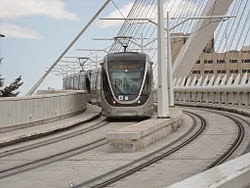
The first image is of a large tunnel being built which will carry the high speed rail line, currently it is scheduled for completion in 2017. The expectation is that using this line, you will be able to get from Downtown Tel Aviv to Jerusalem in 34 minutes and from Ben Gurion airport to Jerusalem in 28 minutes (the Bnai Brak to Jerusalem bus took about 90 minutes with about a dozen different stops).
 The next four images are of the intra Jerusalem area light rail line (first image, from the System web site, is the map of the system). I could have taken this line from the central bus station in Jerusalem to the old city, but the stop is at the Damascus Gate. It isn't too far from the Western Wall (my destination) but it is confusing to walk through the Old City and I have several times gotten turned around trying to do this.
The next four images are of the intra Jerusalem area light rail line (first image, from the System web site, is the map of the system). I could have taken this line from the central bus station in Jerusalem to the old city, but the stop is at the Damascus Gate. It isn't too far from the Western Wall (my destination) but it is confusing to walk through the Old City and I have several times gotten turned around trying to do this.  Speaking of the Damascus Gate, the next image is from near there and shows the first passenger carrying light rail train in 2011 (image from the web).
Speaking of the Damascus Gate, the next image is from near there and shows the first passenger carrying light rail train in 2011 (image from the web). The final two images show different perspectives of the Chords bridge (a.k.a., the Bridge of Strings, the Jerusalem Bridge of Strings, the Gesher HaMeitarim).
The first image of the bridge was apparently taken from the rail line itself (and from the internet).
 The bridge is about 1.5 miles (and 5 passenger stops) NW of the border of the old city. The individual steel cables (there are 66 of them) holding the deck are about 500' long and the bridge itself (cables, superstructure, substructure and deck) is about 1500' long and weigh about 4500 tons. This sounds like a lot but the just the cables alone which hold the deck of the east bay part of the Oakland Bay Bridge (also a one tower cable stayed bridge) weigh about that amount (total weight of that bridge, counting structure, connectors and deck, is probably more than 100,000 tons).
The bridge is about 1.5 miles (and 5 passenger stops) NW of the border of the old city. The individual steel cables (there are 66 of them) holding the deck are about 500' long and the bridge itself (cables, superstructure, substructure and deck) is about 1500' long and weigh about 4500 tons. This sounds like a lot but the just the cables alone which hold the deck of the east bay part of the Oakland Bay Bridge (also a one tower cable stayed bridge) weigh about that amount (total weight of that bridge, counting structure, connectors and deck, is probably more than 100,000 tons).  The next image shows the bridge as seen from street level (taken by me). As one can tell, the bridge is a one tower cable stayed bridge. What is even more distinctive (cable stayed bridges are distinctive themselves), is that the tower leans and has two segments at different angles. This was done partly for aesthetics but also because the bridge has a curve and if the there were no leaning cable stay tower, I think it would have required a second tower (short bridges like this with curves in them are also pretty rare).
The next image shows the bridge as seen from street level (taken by me). As one can tell, the bridge is a one tower cable stayed bridge. What is even more distinctive (cable stayed bridges are distinctive themselves), is that the tower leans and has two segments at different angles. This was done partly for aesthetics but also because the bridge has a curve and if the there were no leaning cable stay tower, I think it would have required a second tower (short bridges like this with curves in them are also pretty rare).
No comments:
Post a Comment